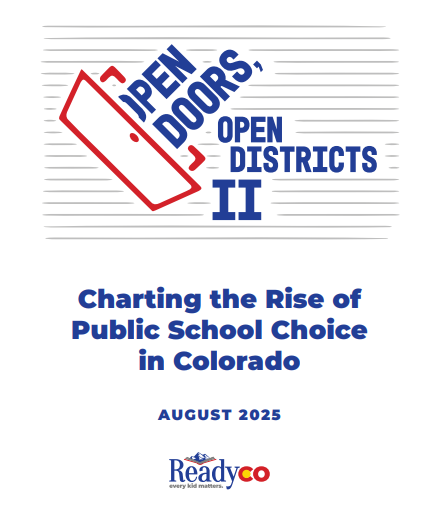by Erica Jedynak, chief operating officer, yes. every kid.
Colorado’s public school open enrollment policies stand out among the nation – for not only expanding parental choice, but for also catalyzing educational innovation in school districts across the state. According to a new report from education nonprofit, Ready Colorado, nearly 40% of students in the Centennial State now attend schools outside their assigned zones.
State law requires districts to accept out-of-boundary students when space permits but leaves implementation details to the local level. Thankfully for students, Colorado’s policy framework encourages rather than constrains innovation.
The Innovation Imperative
When families can vote with their feet, districts must earn their enrollment. This market dynamic has prompted three districts to pursue distinctly different strategies to attracting students and the formula funds that come with them. Captured in the “District Deep Dives” within Ready Colorado’s Open Doors, Open Districts II, each reveals how bottom-up policy frameworks can foster institutional change.
Mapleton Public Schools, just north of Denver, took the most radical approach: they eliminated assigned schools entirely. Their 100% choice model empowers every family to actively select a school, transforming the old model into an opportunity for genuine engagement. The district redesigned its 19 schools around specific educational philosophies: STEM, Expeditionary Learning, Big Picture, Dual Language, etc., creating a portfolio of options within a single system.
The results speak for themselves: 60% of Mapleton students attend a school other than their neighborhood default, the highest rate among all Colorado districts analyzed. Families are clearly satisfied. But more importantly, the district has embedded choice so deeply into its culture that families embrace the selection process as a key piece of their empowerment. As Ready Colorado notes, “While placement depends on factors like space, grade-level openings, and overall capacity, most students are placed in their first-choice school.”
Denver Public Schools demonstrates how large urban systems can maintain coherence while expanding choice. Rather than fragmenting into competing schools, DPS created enrollment zones that guarantee families access to multiple high-quality options while preserving efficiency in transportation. Their SchoolChoice system processes thousands of applications annually, with most families securing seats at their top preferences.
By maintaining enrollment zones, providing targeted support for multilingual families, and employing mobile apps, DPS ensures that open enrollment serves every kid who wants to use it.
Academy District 20 in the Colorado Springs area leans into its strength in specialization, leveraging choice to offer career-focused pathways—automotive studies, aerospace, graphic design—that would be nearly impossible to replicate in every neighborhood school. Their satellite bus system extends access to these specialized programs to families across district boundaries, drawing over 3,900 out-of-district transfers annually.
Policy Lessons for State Leaders
Colorado’s open enrollment model has been successful because it has incentivized districts to specialize their offerings, illuminating what a transformed educational policy landscape can offer kids and families.
The transportation challenge deserves particular attention. Mapleton provides buses to all families transferring in-district, recognizing that mobility enables opportunity. Academy District 20’s satellite stops reduce driving burdens while maintaining choice access. The district even offers a bus tracking app to assist students with finding the right bus and give families more assurance their children are traveling safely to school.
These solutions emerged because state policy created incentives for districts to solve transportation barriers rather than hide behind them.
Despite this real progress, significant obstacles remain. Application processes vary wildly across districts, creating unnecessary friction for families. Seat availability information stays largely opaque, forcing parents to guess rather than plan. Transportation gaps still exclude families who cannot provide their own solutions.
The Path Forward
Colorado’s approach to open enrollment shows how empowering families can transform education. When districts must compete for students, they become more responsive, more innovative, and more specialized in attracting the funds those students bring with them. They develop unique identities and value propositions instead of leaning on the old one-size-fits-all model.
For other states, the lesson is clear: enforce open enrollment rights and encourage local flexibility. For districts: invest in transportation and demand transparency to ensure families know their options.
Ultimately, open enrollment works best when it sparks improvement, leading to more satisfying and more meaningful choices for families.

